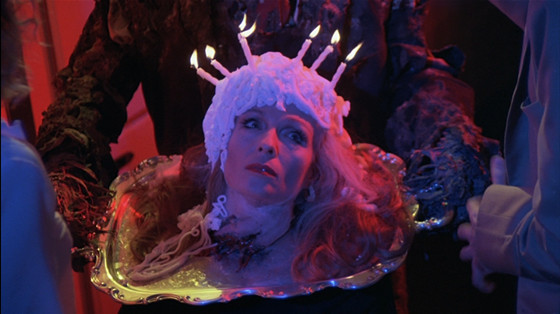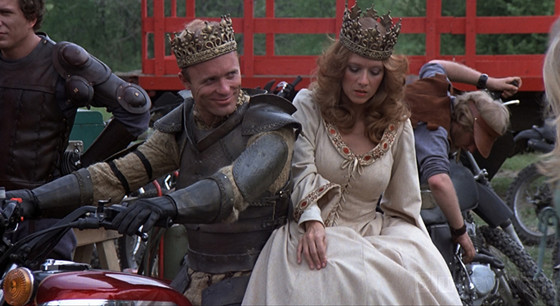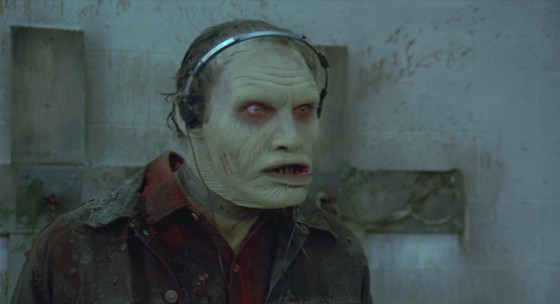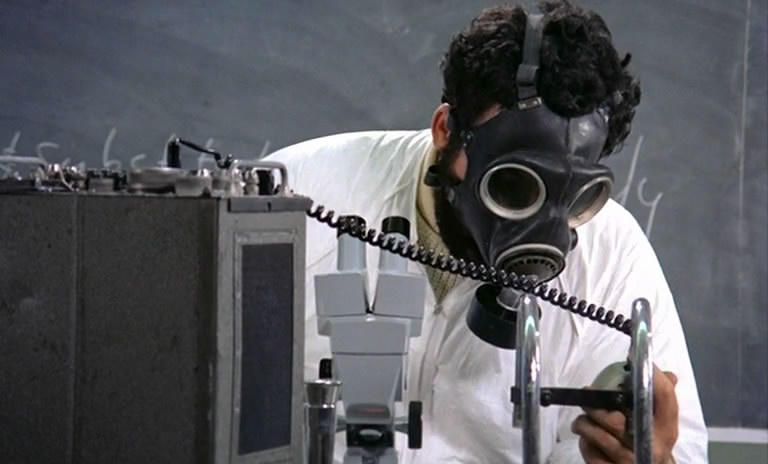7. Creepshow (1982)
The Plot
In Creepshow a set of five horrific yet humorous tales unfolds before us, linked together by a young boy reading a comic book. Father’s Day follows a group of family members reminiscing about their father’s death under suspicious circumstances, only for the father to return from the grave to collect his Father’s Day treat.
The next story, The Lonesome Death of Jordy Vierrill, involves a simple country yokel called Jordy, who after finding a meteor in his back yard becomes the victim of a horrible infection. Something To Tide You Over focuses on Richard Vickers, a scorned man who devises a very watery and sinister revenge for the adulterers who have crossed him. Unfortunately for Richard, the adulterous couple return to inflict their own brand of punishment on him.
The Crate involves a recently found box which has been hidden in a college basement for over 148 years. Dexter Stanley, a college custodian, finds to his horror that there is in fact something living within the crate. Slowly driven mad by what he has seen, he decides to use this crate for his own schemes.
The final tale is called They’re Creeping Up On You and follows Upson Pratt, a mysophobe who lives in a sealed apartment to avoid contracting any diseases. When a power cut hits New York, his apartment is suddenly accessible to an intruder of the scuttling and creepy kind.
Why It’s So Great
Creepshow is the collaboration between director George A. Romero and writer Stephen King. Romero has worked on films like this throughout his career. Two Evil Eyes with director Dario Argento is one such collaboration. In Creepshow the two horror masters work together well with their personal styles combining to form a thoroughly entertaining horror anthology. Both King’s and Romero’s love of the old EC comic style is evident throughout, with each tale having an ending that incorporates the love of the morbid as well as the ironic.
Most of the stories involve the twisted sense of righteousness that EC comics loved, with the guilty being punished in horrific ways. The only story that diverges from this template is The Lonesome Death Of Jordy Vierrill (written by King) which has a very tragic ending for a man whose only crime was stupidity.
With its use of well-known actors in small yet shocking roles, it set the stage for other shows to take this format and run with it, like the popular TV show Tales from the Crypt. Ironic that the journey has come full circle, with a movie based on that comic’s exploits helping to set a template for a series based on the comic.
Strangely for an anthology all the stories entertain and few tales are disappointing – a problem almost all these types of movies suffer from. This is in part because of the direction of Romero and the writing of King. The use of comic book panels, coloured filters on key scenes, freeze frames and animated comic art to link the sections together, all help to keep the audience’s attention, as well as making it feel like a comic book is coming to life before our very eyes.
Tom Savini, who has worked on a number of Romero’s movies, uses his extensive make-up artistry to great effect, with some of the most fantastic creature effects being lavishly displayed on screen. The best is the yeti-like creature that lives within the crate. The creature’s larger-than-life appearance reinforces the comic book element to the movie.
In fact, the movie’s constant visual changes make for a fascinating yet disorientating viewing experience which becomes very unearthly, creating its own comic book reality where all these events somehow seem plausible.
Unlike some of the films that followed it, there is a large amount of comedy in this movie. From Jordy’s vivid and over the top day dreams, to the zombie father who brings his own cake to his party and the fantasies Dexter has about killing his wife – they all mix the macabre with hilarity.
Some of Romero’s directorial flourishes remain evident in this ensemble piece. It was filmed in Pittsburgh, with many of Romero’s usual actors coming on board to play key roles.
The sense of alienation seen in films like Night of the Living Dead is evident in almost all of these tales: Jordy lives alone; Upson entraps himself in his own apartment; the yeti creature is kept in its crate and people are lured to its spot under the stairs; most of the family members in Father’s Day stay in the house and worry about the few family members that strayed from it; and Richard Vickers is attacked in his own home.
The film is also quite scary, with key jump scenes which add the thrills and chills. The reveal of the zombie in Father’s Day is genius and is not easily predictable; the slow infiltration into Upson’s sealed room causes the chills for both him and the viewer; the use of the crate and the audience’s knowledge of what is in the crate works perfectly to create fear; and finally the most chilling of all is the grim fate reserved for Richard, whose house is filled with CCTV cameras, causing dread by revealing only brief glimpses of what is passing by.
6. Knightriders (1981)
The Plot
To the general public, the Knightriders are just a group of travelling mediaeval performers who ride motorcycles in their combat tournaments rather than using the more traditional method of horse riding. To the misfits who make up the Knightriders, however, the group means much more. This is especially true of Billy, or King William, who has taken his role as king very seriously.
This dedication comes at a price, and it causes some distance between the group members when King William makes some dubious decisions. When other members of the team decide to branch off to create their own version of the Knightriders in the hope of making some money, the group’s dynamic starts to change. Will King William be able to bring all these people back together before the group falls apart?
Why It’s So Great
Knightriders is a perfect example of Romero’s skill with character development. This ensemble piece has a running time of well over 2 hours but the time is used wisely, with story arcs and plot developments slowly laid out for the audience to see unravel. A great example of this is the 40-minute introduction scene. It takes the audience from the start of the Knightriders day all the way through to their nocturnal activities.
Through this process we are able to bond with the characters and become fully immersed in the community. The film perfectly blends soap opera style personal problems, with mediaeval ethics all enclosed in a modern day setting. Romero does not just rely on dialogue to express this. He gives us some rather tense action scenes which include jousting on motorbikes, contact fighting and motorcycle races thus balancing out the drama.
Romero loves to explore society in his films and this movie, in a small part, focuses on the modern American’s perspective on the Knightriders. We see all this through the Knightriders’ eyes, making us as the viewer instantly side with them. Harassment from the cops is one thing, but heckling audiences and red neck style bikers stealing their property are some of the other issues the group has to deal with.
But the group themselves are not without their faults, with the public getting caught in the crossfire and members of the group getting injured. Romero shows us that even though this seems like a glamorous and exciting world to escape to, it has its risks. This social commentary is juxtaposed with comedic elements in the movie, courtesy of the resident monk, who is just as happy putting down ungrateful audience members as he is leering over naked flesh.
The main idea of the movie is the importance of having honour and respect for a brother in arms. This is what drives the characters’ motivations. Even when they leave the group for their own reasons, it is because they feel their voices are not being heard. Romero tries to give each of his cast small moments to shine, but it is King Billy (played as deadly serious by a fantastic Ed Harris) and Morgan (one of Tom Savini’s best performances) who really drive the story forward.
These characters are mirror images of each other. Billy is desperate to hold onto the world he has crafted for himself and his ethics regarding the group are so strong that he goes to jail for them. But it is this rigid outlook on life with alienates him from the very people who surround him. Morgan on the other hand has fresh new ideas, but is seen as a thorn in Billy’s side, even when Billy’s decisions are incorrect. Morgan’s lust for fame, however, makes him lose his way and he forgets the purpose of the Knightriders and why he joined.
The end of the film perfectly blends these two characters’ story arcs for a heart-warming conclusion. Romero cannot resist adding some bleakness to his tale though and the ending, which may seem uncalled for, does fit the storyline arcs and enables a certain amount of closure.
5. Day of the Dead (1985)
The Plot
It seems humanity has lost its battle with the undead. The military and civilians now live together in colonies, with the military protecting them against zombie invasion. Groups go out and look for survivors but never find anything other than the undead whose numbers are now overwhelming.
We follow a group of these survivors who are hiding out in the Everglades. The group live a fractured existence with the military crew constantly clashing with the doctors and none military staff who live there. This becomes worse when Dr Logan (dubbed Frankenstein because of his love for experimenting on the dead) needs more and more corpses for his work but fails to find a cure.
When the volatile and possibly deranged Captain Henry Rhodes discovers a secret Dr Logan had been keeping from him, he finally snaps. While this is going on, Miguel (a soldier who was bitten when attempting to procure test subjects for Dr Logan, but saved when the bitten appendage was cut off) also starts to lose his grip on reality. These two events combine to cause the group’s downfall.
Why It’s So Great
Day of the Dead manages to show the bleakness of human existence in a zombie ravaged land. Romero shows the claustrophobia within a group that has been separated from humanity, focusing on how this is causing the surviving members to bicker and become aggressive.
It also shows the loss of hope, with some of the survivors fearing they are the only ones left alive while others know they are and care only about keeping themselves alive. Selfish actions and constant aggression hides the fact that many of the survivors are scared of being alone and that they have entirely lost their humanity. When Bub the zombie comes across as more human than some of the people in the movie, you know there is a problem.
Isolation is the key here. Whenever they go to cities, there are no people there, only the dead. Down below, the dead still hang around and are ever present no matter how deep down humanity goes to hide from them. The living are not much better off than the dead. Nor are they safer down below, with Captain Henry Rhodes, a man that is so mentally unstable, he will shoot non-military staff trapped down in the base with him if they do not agree to his demands.
Doctor Logan seems equally disturbed and is happy cutting up the dead, as much for his own amusement as for scientific advancement. This may be the reason why there is so much friction between the two of them, even before the doctor’s secret is revealed.
The civilians, including Dr Sarah Bowman, Bill McDermott and John, as well as Miguel whom Sarah seems to have a relationship with, are the only relatable people there and they live in fear. This social divide was taken one step further in Land Of The Dead, but here you can see the differences slowly creeping up. It is ironic that Doctor Logan, who can only relate to the dead, creates the most human of all zombies, Bud.
Bud is one of the greatest on-screen zombies in history. The glint of humanity can still be seen in his eyes and his interactions with objects that humans use on a regular basis is fascinating to watch. Romero teases us with the notion that the spark of human life may still be there, hidden under the surface.
This is most evident at the end of the film when after his surrogate father is killed, he takes his revenge on the killer by shooting him in the gut rather than killing him outright. This sense of revenge is reinforced when Bud salutes the man as he is eaten alive, a throwaway mocking gesture of disdain for the killer.
Aside from the generally depressing feeling the movie evokes in the viewer, it is also an incredibly gory affair. Make-up effects had come a long way and Romero utilises this to great effect, with the audience seeing every rip of flesh that occurs. The zombie make-up effects are incredibly powerful, adding an extra element of fear to the movie.
With the group seemingly secure, it is nerve racking when the base is compromised by one of their own people. This is another element Romero expands on in Land, but it seems much more effective in this movie.
4. The Crazies aka Code Name: Trixie (1973)
The Plot
Evans City, Pennsylvania finds itself in a state of panic when an untested military bio-weapon is accidently let loose in the local water supply. The weapon, code named Trixie, has two possible effects on the persons infected. They either die or start to go slowly insane and eventually turn to extreme violence.
The story unfolds from two viewpoints. We follow a small group of uninfected citizens as they are removed from their homes with extreme prejudice by US soldiers in decontamination suits. While being removed to a safe location, this group is attacked by the infected (or “Crazies”) and have to fend them off.
While they are looking for an escape from the city, they find themselves on the run from both the army troops and the infected. The other viewpoint follows the behind-the-scenes work of the military staff and the politicians who are trying to keep a lid on the news of the outbreak as well as trying to keep the outbreak from spreading any further.
Why It’s So Great
The Crazies follows a similar plot structure to Romero’s first hit, Night Of The Living Dead. It involves a group of people suddenly thrust into a completely unfamiliar situation and, while trying to escape the problem, the group dynamic slowly begins to break down. Like a zombie bite, Trixie infects the group.
Unlike zombie bites, however, there are no markings to show who the infected are. This becomes part of the fun of the film, watching and waiting for the turned to show their face. Having to watch for signs of how each character is behaving adds an extra level of tension to the movie. Like Romero’s zombie virus, Trixie takes over the people we once knew and turns them into something we no longer recognise.
Horror has a human face in most of Romero’s works and this is seen throughout The Crazies. The great thing about using an unseen infection is that when the characters encounter someone new, you are never sure whether they are infected or not. This leads to some brilliant and scary scenes. One of the more shocking of these is an attack by an elderly lady sitting in a chair. Her knitting needles rise to stab anyone who gets too close, then she resumes her knitting.
Much like in Night, The Crazies uses the villain of the piece purely as an excuse to show how easily society can break down. But while in Night we can see the problems (the zombies), with The Crazies the problem is everywhere and the group is in a constantly hostile and dangerous environment. The group that manages to escape the military at the start slowly starts to break down because of the unrelenting pressure.
Trixie causes members of the group to do unspeakable things to one another (in one shocking scene we see an incest-related rape), destroying the group’s morale to such an extent that the sole survivor gives in when the military finally corner the group, not knowing any other way to escape and not caring either way.
So disillusioned is the survivor, he declines to tell his rescuers that he is immune to the infection. Not that the military can help or that they have any ideas of their own other than containment. In fact, the military loses control more quickly than the survivors fleeing the infection.
No one can find a cure and the military’s attempts at containment fail, mostly due to the lack of preparation, the general panic from their attempts to contain the situation and the survivors fighting back against their mistreatment. The ending shows the misjudgement of the military even more explicitly when the doctor working on the cure is taken away for quarantine. The audience is not sure if he has a cure, or even if he is infected. But the military’s bad handling of the situation means that two potential cures are never discovered.
With the Vietnam War still going on, Romero uses his movie to show public feeling at the time towards political figures in positions of power. The use of flamethrowers by the government in Crazies to kill the infected becomes a reminder of the bombings in Vietnam at that time. It is perhaps Romero’s most aggressive look at social events in any of his movies and the most troubling because the sequence of events it shows could easily become real.



